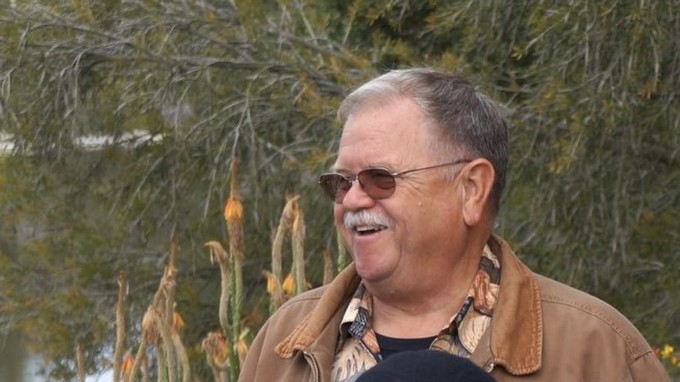
On Wednesday, Warren Roberts guides free tour of earliest fall color

Warren Roberts, superintendent emeritus of the UC Davis Arboretum, returns Wednesday to lead one of his entertaining walks. Photo courtesy UC Davis Arboretum and Public Garden
UC Davis Arboretum’s beloved tour guide returns to action this week. It’s time again for “Walks with Warren.”
This week, Warren Roberts – the Arboretum’s superintendent emeritus – resumes his monthly free tours of the gardens he helped create. The first will be noon, Wednesday, Sept. 13, and focused on the Arboretum’s first hints of fall foliage as well as late summer blooms.
Meet Roberts at the Gazebo in the Carolee Shields White Flower Garden on the UC Davis Campus and be prepared for a lively hour-long stroll, packed with botanical knowledge spiked with wordplay. Admission is free.
“Get ready to immerse yourself in the vivid beauty of autumn as you embark on a midday adventure through the gardens and collections of the UC Davis Arboretum with your guide Warren Roberts, superintendent emeritus,” say the organizers. “Renowned for his captivating storytelling and playful puns, Warren leads participants on an always-engaging exploration of the Arboretum's seasonal highlights.
“Whether you're a seasoned plant enthusiast or simply eager to revel in the tranquility of nature, this experience promises to be both educational and delightful,” they add. “This event is open to all and free of charge, encouraging everyone to come together and embrace the wonders of nature within the Arboretum's picturesque grounds.”
Although the tour is free, parking is not. Parking ($1.75 per hour) is available along Garrod Drive near the Gazebo via AggiePark on the AMP Park app. Other parking is available in Visitor Lot 55; that lot requires a $15 daily parking permit, also via AggiePark.
Details and directions: https://arboretum.ucdavis.edu/. Phone: 530-752-4880.
Comments
0 comments have been posted.Sacramento Digs Gardening to your inbox.
Food in My Back Yard Series
April 22: Should you stock up on fertilizer? (Yes!)
April 15: Grow culinary herbs in containers
April 8: When to plant summer vegetables
April 1: Don't be fooled by these garden myths
March 25: Fertilizer tips: How to 'feed' your vegetables for healthy growth
March 18: Time to give vegetable seedlings some more space
March 11: Ways to win the fight against weeds
March 4: Potatoes from the garden
Feb. 25: Plant a fruit tree now -- for later
Feb. 18: How to squeeze more food into less space
Feb. 11: When to plant? Consider staggering your transplants
Feb. 4: Starting in seed starting
Sites We Like
Garden Checklist for week of April 27
Once the clouds clear, get to work. Spring growth is in high gear.
* Set out tomato, pepper and eggplant transplants.
* From seed, plant beans, beets, cantaloupes, carrots, corn, cucumbers, melons, pumpkins, radishes and squash. Plant onion sets.
* In the flower garden, plant seeds for asters, cosmos, celosia, marigolds, salvia, sunflowers and zinnias. Transplant petunias, zinnias, geraniums and other summer bloomers.
* Plant perennials and dahlia tubers for summer bloom. Late April is about the last chance to plant summer bulbs, such as gladiolus and tuberous begonias.
* Transplant lettuce and cabbage seedlings.
* Weed, weed, weed! Don’t let unwanted plants go to seed.
* April is the last chance to plant citrus trees such as dwarf orange, lemon and kumquat. These trees also look good in landscaping and provide fresh fruit in winter.
* Feed citrus trees with a low dose of balanced fertilizer (such as 10-10-10) during bloom to help set fruit. Keep an eye out for ants.
* Apply slow-release fertilizer to the lawn.
* Thoroughly clean debris from the bottom of outdoor ponds or fountains.
* Start thinning fruit that's formed on apple and stone fruit trees -- you'll get larger fruit at harvest (and avoid limb breakage) if some is thinned now. The UC recommendation is to thin fruit when it is about 3/4 of an inch in diameter. Peaches and nectarines should be thinned to about 6 inches apart; smaller fruit such as plums and pluots can be about 4 inches apart. Apricots can be left at 3 inches apart. Apples and pears should be thinned to one fruit per cluster of flowers, 6 to 8 inches apart.
* Azaleas and camellias looking a little yellow? If leaves are turning yellow between the veins, give them a boost with chelated iron.
* Trim dead flowers but not leaves from spring-flowering bulbs such as daffodils and tulips. Those leaves gather energy to create next year's flowers. Also, give the bulbs a fertilizer boost after bloom.
* Pinch chrysanthemums back to 12 inches for fall flowers. Cut old stems to the ground.
* Mulch around plants to conserve moisture and control weeds.